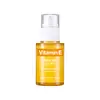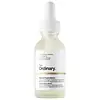What's inside
What's inside
 Key Ingredients
Key Ingredients

 Benefits
Benefits

 Concerns
Concerns

No concerns
 Ingredients Side-by-side
Ingredients Side-by-side

Water
Skin ConditioningGlycerin
HumectantPropanediol
SolventCoco-Caprylate/Caprate
Emollient1,2-Hexanediol
Skin ConditioningPolyglyceryl-3 Distearate
EmulsifyingBetaine
HumectantPanthenol
Skin ConditioningChlorella Vulgaris Extract
Skin ConditioningGlucose
HumectantButylene Glycol
HumectantFructooligosaccharides
HumectantFructose
HumectantXanthan Gum
EmulsifyingAcrylates/C10-30 Alkyl Acrylate Crosspolymer
Emulsion StabilisingTocopheryl Acetate
AntioxidantTromethamine
BufferingCitrus Aurantium Dulcis Oil
MaskingGlyceryl Stearate Citrate
EmollientEthylhexylglycerin
Skin ConditioningCupressus Sempervirens Oil
MaskingLavandula Hybrida Oil
EmollientRosmarinus Officinalis Leaf Oil
MaskingLitsea Cubeba Fruit Oil
MaskingTocopherol
AntioxidantSucrose Palmitate
EmollientHydrogenated Lecithin
EmulsifyingMacadamia Ternifolia Seed Oil
EmollientOlea Europaea Fruit Oil
MaskingSimmondsia Chinensis Seed Oil
EmollientVitis Vinifera Seed Oil
EmollientWater, Glycerin, Propanediol, Coco-Caprylate/Caprate, 1,2-Hexanediol, Polyglyceryl-3 Distearate, Betaine, Panthenol, Chlorella Vulgaris Extract, Glucose, Butylene Glycol, Fructooligosaccharides, Fructose, Xanthan Gum, Acrylates/C10-30 Alkyl Acrylate Crosspolymer, Tocopheryl Acetate, Tromethamine, Citrus Aurantium Dulcis Oil, Glyceryl Stearate Citrate, Ethylhexylglycerin, Cupressus Sempervirens Oil, Lavandula Hybrida Oil, Rosmarinus Officinalis Leaf Oil, Litsea Cubeba Fruit Oil, Tocopherol, Sucrose Palmitate, Hydrogenated Lecithin, Macadamia Ternifolia Seed Oil, Olea Europaea Fruit Oil, Simmondsia Chinensis Seed Oil, Vitis Vinifera Seed Oil
Water
Skin ConditioningGlycerin
HumectantAlgae Extract
EmollientPseudoalteromonas Exopolysaccharides
Skin ConditioningPseudoalteromonas Ferment Extract
HumectantAhnfeltia Concinna Extract
Skin ConditioningArginine
MaskingGlycine
BufferingAlanine
MaskingSerine
MaskingValine
MaskingIsoleucine
Skin ConditioningProline
Skin ConditioningThreonine
Histidine
HumectantPhenylalanine
MaskingAspartic Acid
MaskingPCA
HumectantSodium PCA
HumectantSodium Lactate
BufferingSalicylic Acid
MaskingCitric Acid
BufferingPropanediol
SolventDimethyl Isosorbide
SolventEthoxydiglycol
HumectantPolysorbate 20
EmulsifyingPotassium Sorbate
PreservativeSodium Salicylate
PreservativeSodium Benzoate
MaskingHexylene Glycol
Emulsifying1,2-Hexanediol
Skin ConditioningPhenoxyethanol
PreservativeCaprylyl Glycol
EmollientWater, Glycerin, Algae Extract, Pseudoalteromonas Exopolysaccharides, Pseudoalteromonas Ferment Extract, Ahnfeltia Concinna Extract, Arginine, Glycine, Alanine, Serine, Valine, Isoleucine, Proline, Threonine, Histidine, Phenylalanine, Aspartic Acid, PCA, Sodium PCA, Sodium Lactate, Salicylic Acid, Citric Acid, Propanediol, Dimethyl Isosorbide, Ethoxydiglycol, Polysorbate 20, Potassium Sorbate, Sodium Salicylate, Sodium Benzoate, Hexylene Glycol, 1,2-Hexanediol, Phenoxyethanol, Caprylyl Glycol
 Reviews
Reviews

Ingredients Explained
These ingredients are found in both products.
Ingredients higher up in an ingredient list are typically present in a larger amount.
1,2-Hexanediol is a synthetic liquid and another multi-functional powerhouse.
It is a:
- Humectant, drawing moisture into the skin
- Emollient, helping to soften skin
- Solvent, dispersing and stabilizing formulas
- Preservative booster, enhancing the antimicrobial activity of other preservatives
Glycerin is already naturally found in your skin. It helps moisturize and protect your skin.
A study from 2016 found glycerin to be more effective as a humectant than AHAs and hyaluronic acid.
As a humectant, it helps the skin stay hydrated by pulling moisture to your skin. The low molecular weight of glycerin allows it to pull moisture into the deeper layers of your skin.
Hydrated skin improves your skin barrier; Your skin barrier helps protect against irritants and bacteria.
Glycerin has also been found to have antimicrobial and antiviral properties. Due to these properties, glycerin is often used in wound and burn treatments.
In cosmetics, glycerin is usually derived from plants such as soybean or palm. However, it can also be sourced from animals, such as tallow or animal fat.
This ingredient is organic, colorless, odorless, and non-toxic.
Glycerin is the name for this ingredient in American English. British English uses Glycerol/Glycerine.
Learn more about GlycerinPropanediol is an all-star ingredient. It softens, hydrates, and smooths the skin.
It’s often used to:
Propanediol is not likely to cause sensitivity and considered safe to use. It is derived from corn or petroleum with a clear color and no scent.
Learn more about PropanediolWater. It's the most common cosmetic ingredient of all. You'll usually see it at the top of ingredient lists, meaning that it makes up the largest part of the product.
So why is it so popular? Water most often acts as a solvent - this means that it helps dissolve other ingredients into the formulation.
You'll also recognize water as that liquid we all need to stay alive. If you see this, drink a glass of water. Stay hydrated!
Learn more about Water